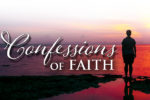 |
Everything in Luther’s catechism revolves around the forgiveness of sins in Jesus.
The Ten Commandments reveal sins that need forgiving. The Apostles’ Creed proclaims the forgiveness of sins in Jesus’ life and death. And in the Lord’s Prayer, Jesus tells us to plead, “Forgive us our sins.”
But how do you genuinely know that forgiveness is for you? How are you personally assured of forgiveness?
God’s distribution system
That’s where the other three chief parts of the catechism come in: the keys and the Sacraments of Baptism and the Lord’s Supper. They are the distribution system that brings Christ’s word of forgiveness from his cross to your heart.
Consider what Luther said in his treatise Against the Heavenly Prophets: “If now I seek the forgiveness of sins, I do not run to the cross, for I will not find it given there. . . . But I will find in the sacrament or gospel the word which distributes, presents, offers, and gives to me that forgiveness which was won on the cross” (Luther’s Works, Vol. 40, p. 214).
In other words, the cross is where Christ achieved and won the forgiveness of sins for you. But he doesn’t tell you to journey to that cross in some abstract way to find your forgiveness there. Instead, he comes to you. He brings forgiveness to you concretely—through his word of absolution spoken directly to you and by his Word connected to physical elements in the sacraments. Jesus’ promise is brought right to you in the absolution, in Baptism, and in the Supper.
Luther saw this distribution system outlined in Scripture and made it part of a catechism packed with comfort.
God’s meal of fulfillment
If you could pick only one book of Scripture to study how Christ distributes his forgiveness, go to Matthew. He is the evangelist who reports when Jesus gave the keys to the church (Matthew chapters 16 & 18) and when he commanded the church to baptize (Matthew chapter 28).
And along with Mark, Luke, and Paul (in 1 Corinthians), Matthew records the institution and the benefit of the Lord’s Supper—the night when Jesus replaced the Old Testament meal of promise with his New Testament meal of fulfillment.
When the Jews ate the sacrificed Passover lamb, it reminded them of their ancestors’ blood-bought deliverance from Egypt, but it also foreshadowed when the Lamb of God would redeem us with his blood.
Matthew was in the room when Jesus instituted the Lord’s Supper. “While they were eating, Jesus took bread, and when he had given thanks, he broke it and gave it to his disciples, saying, ‘Take and eat; this is my body.’ Then he took a cup, and when he had given thanks, he gave it to them, saying, ‘Drink from it, all of you. This is my blood of the covenant, which is poured out for many for the forgiveness of sins’ ” (Matthew 26:26-28).
When the Supper is offered, Jesus invites you to eat and drink his body and blood in, with, and under the bread and wine for the forgiveness of your sins. This sacrament points you backward to Jesus’ once-and-for-all sacrifice for your sins.
It also foreshadows the next meal. This one little detail of the coming marriage feast of the Lamb Matthew alone records: Immanuel promised he will enjoy this heavenly banquet “with you” in his Father’s kingdom (Matthew 26:29).
This is the fifth article in a six-part series about catechism truths found in Matthew’s gospel.
Learn more at forwardinchrist.net/catechism.
Author: James Borgwardt
Volume 110, Number 11
Issue: November 2023







